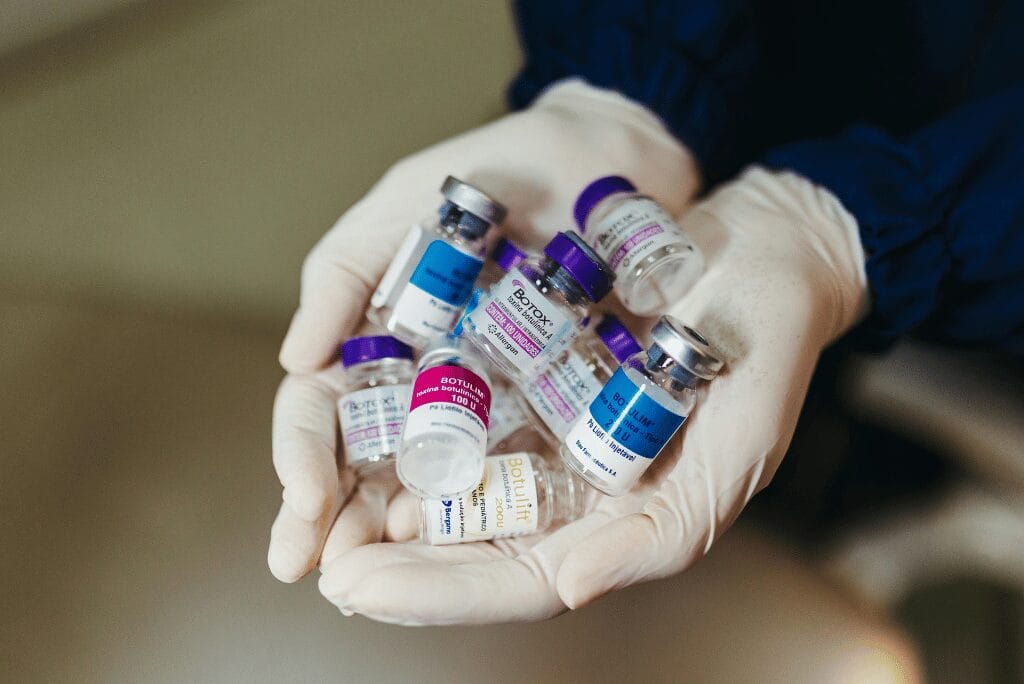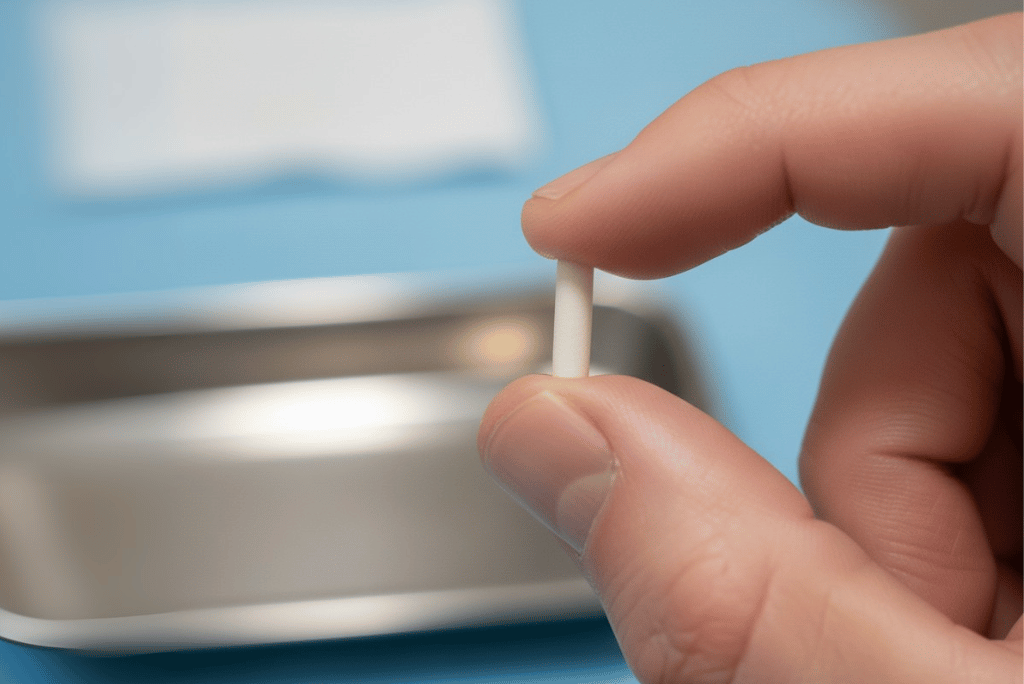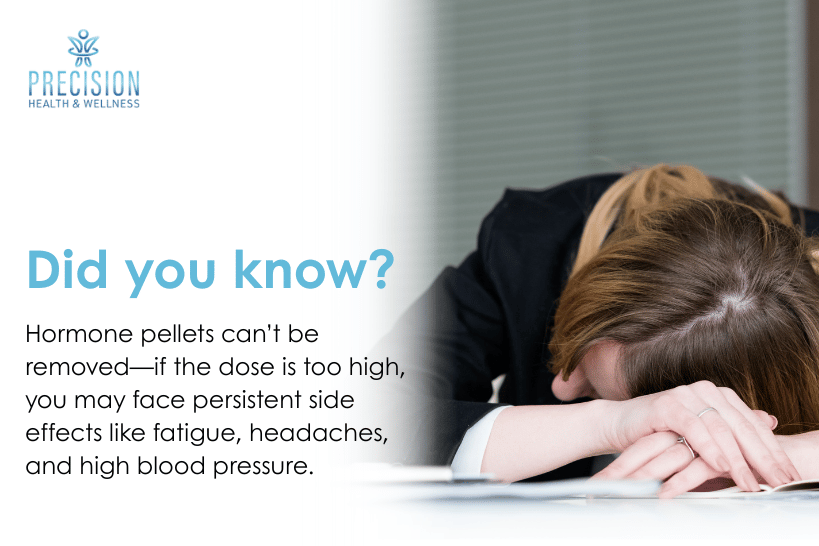

Hormone therapy can help people manage symptoms caused by hormonal imbalances. One option is pellet therapy, which uses small hormone pellets placed under the skin. These pellets slowly release bioidentical hormones over several months. While many patients report symptom relief, it’s important to understand the downsides of hormone pellets before starting this treatment.
In this article, we break down the risks, side effects, and limitations of pellet therapy so you can make an informed decision about your health.

Hormone pellets are small, rice-sized cylinders made from compressed hormones—usually estrogen or testosterone. Healthcare providers insert them just under the skin, often in the hip or buttock, during a simple in-office procedure.
Pellet therapy is a form of hormone replacement therapy (HRT). It’s used to treat symptoms related to hormone imbalance, such as low energy, poor sleep, mood swings, and weight changes. The hormones in these pellets are typically bioidentical hormones, meaning they are chemically identical to the hormones your body naturally produces.
Like any form of hormone therapy, pellet implants come with possible side effects. The most common ones include:
Hormone levels affect mental health. Some patients report mood changes, including anxiety, depression, or agitation, after starting pellet therapy. Others see emotional highs and lows that can resemble mood swings. These symptoms may improve as hormone levels stabilize, but that adjustment period can be uncomfortable.
Many patients have concerns about weight gain. Some gain weight when starting hormone replacement therapy, especially during the first few months. The cause isn’t always clear. Water retention, increased appetite, or changes in metabolism could play a role. While not everyone gains weight, it’s a reported risk.

Any time your skin is broken, as with the pellet insertion procedure, there’s a small risk of infection. Bruising, swelling, or discomfort at the site can also occur. Proper hygiene and a skilled provider can reduce these risks, but they can’t remove them entirely.
Some individuals report unwanted hair growth or thinning of scalp hair. These effects may relate to how the body processes testosterone, especially when hormone levels rise too quickly.
One goal of hormone replacement is to improve sexual health, but outcomes vary. Some patients experience a boost in libido, while others feel no change—or see a drop. In some cases, too much hormone can create problems with emotional closeness or irritability in relationships.
Related Article: Top 9 Benefits of Hormone Replacement Therapy in Men’s Health
One of the major downsides of hormone pellets is a lack of flexibility. Once the pellets are inserted, they release hormones consistently for several months. You can’t adjust the dose easily if side effects occur.
If hormone levels rise too high or drop too low between pellet replacements, symptoms can return or worsen. Unlike pills or creams that you can change or stop, pellets remain active until they dissolve. For some patients, this inflexibility leads to frustration—or a long wait for symptoms to improve.

Although pellet therapy aims to deliver steady hormone levels, the body doesn’t always absorb them evenly. Several factors can affect absorption, including your metabolism, activity level, and body composition. Some people metabolize pellets quickly, creating spikes and crashes in hormone levels.
This uneven absorption can lead to hormonal imbalances, the very issue that hormone replacement therapy is meant to address. As symptoms fluctuate, it becomes harder to judge whether the therapy is working—and what needs to be changed.
Another downside: pellet therapy can be expensive, and many insurance plans do not cover it. Because the treatment lasts several months, it’s a recurring cost. This makes it harder for some patients to commit to regular hormone treatments.
Other forms of hormone replacement, like patches, pills, or injections, may be more affordable or covered by insurance. It’s worth weighing the financial investment alongside the possible benefits.
Hormone replacement therapy, especially in pellet form, isn’t right for everyone. Patients with certain medical histories—including breast cancer, blood clots, liver disease, or heart disease—may face higher risks. A full medical evaluation is necessary before starting any hormone therapy.
In some cases, hormone pellets may worsen conditions like acne, sleep apnea, or aggressive behavior. These effects depend on your hormone levels and sensitivity to hormone changes.

Because hormone pellets can’t be removed after insertion, there is a chance of overdose if the dose is too high. Symptoms of hormone overdose can include:
These signs can resemble the problems people are trying to fix with hormone therapy, adding confusion and frustration.
While hormone therapy and bioidentical hormones have been used for decades, research on long-term pellet use is still limited. Many studies focus on short-term symptom relief. We know less about the safety of pellet therapy over many years.
Patients planning for long-term treatment should ask whether this method remains sustainable and safe over time. Regular monitoring and lab work help track hormone levels and spot unwanted effects. But even with regular care, there are still gaps in what we know about the lasting use of hormone implants.
Hormone pellets offer one way to manage symptoms of hormone imbalance. For some, they’re convenient and deliver steady relief. But they also carry real downsides, including side effects, limited dosing control, uneven absorption, and higher cost. People may also experience mood changes, weight gain, or other unwanted symptoms.
If you’re considering hormone replacement therapy, it’s important to look at the full picture—including the challenges that come with pellet therapy. Talk with your healthcare provider about your health history, goals, and preferences. Compare pellet implants with other forms of hormone replacement, such as patches, gels, or injections.
Deciding whether or not hormone therapy is the route you want to take is not a quick process. It calls for careful thought, medical advice, and a clear understanding of the risks. Knowing the potential downsides of hormone pellets helps you make a more informed, confident choice for your health.


